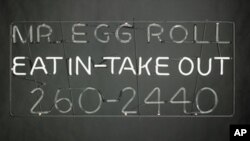Jimmy has been cooking at his Mandarin Wok restaurant in suburban Washington DC for many years. Millions of Americans search out Chinese food every day and find it in thousands upon thousands of small and large Chinese restaurants all over the country. Many are family affairs, like the Mandarin Wok. Jimmy’s son Nelson is one of seven family members, his mother, brother and sisters in addition to his father, who operate the restaurant.
But Nelson says taking over the family restaurant is not necessarily a part of his future, or the plans of his family.
“They want me to work here if I have time to help out. But they want me to go out and do my own thing, get a good job, that’s what they really want. It’s like they’re only doing this to support me and my brother’s education and pay the bills. In the end, we’ll be supporting them," he said.
That is a story of thousands of Chinese families in the United States.
We move from the small confines of the Mandarin Wok to the expanse of the Smithsonian American History Museum in Washington DC. There, in a showcase of the main entry hall is a showcase exploring the history of Chinese food in America
Cedric Yeh, the Smithsonian’s Chairman of Asian and Pacific American Initiatives, said, “It’s part of an ongoing project called the 'Sweet and Sour Initiative' where we are attempting to gather together stories of the Chinese in America through Chinese food and restaurants. We want to be able to talk about the importance of this restaurant and food experience and how it has meant so much more to the community than just a place to eat, to make money and to be able to survive and make a living.”
He said the exhibit is a lifelong dream for him. “I grew up in a Chinese restaurant. So in the back of my mind, I always thought about exploring what that meant to the community. Not just the Chinese community in America but to everyone else," he said.
Yeh says the popularity of Chinese food in the United States is unparalleled.
“One of the amazing numbers that we discovered in our research is that there are over 46,000 Chinese restaurants in the United States. If you threw together all of the burger joints, McDonald’s and the like, it wouldn’t add up to a fraction of that number. That should speak for itself, that you can’t have that level of sustainability unless people clearly find it to be part of their lives," he said.
But don’t think that ordering Chinese food in the United States will be the same as ordering dinner in China. “Chinese restaurants and food that we’ve all grown to love here in America is very much an American food. It might be called Chinese food, but I would say it’s an American staple," he said.
Part of the exhibit, says Yeh is a fortune cookie machine. That is a staple of a Chinese meal here, a cookie at the end of the meal containing a slip of paper with a prediction of your future printed on it.
“The fortune cookie is an iconic symbol in America for Chinese food. The story here is that it is not Chinese. It’s an American invention. Now it’s influenced by Eastern flavors. There are fortune cookie like materials in both Japan and China, but the fortune cookie as we know it in America was invented here," said Yeh.
Concerning the popularity of Chinese food in the US, Yeh said, “It was always cheap, first of all. The people who were selling it kept it affordable. I don’t mean it was cheap as in shoddy but it was affordable. That helped keep its place in the choices people had. Even if you didn’t like the Chinese people, you would go and eat there because they offered you a good deal. The other reason was the sense of exoticism. Those two factors added together created almost an irresistible pull for many Americans They wanted a sense of the exotic, a journey where they thought they were experiencing for the first time the Chinese culture I think appealed to a lot of people.”






